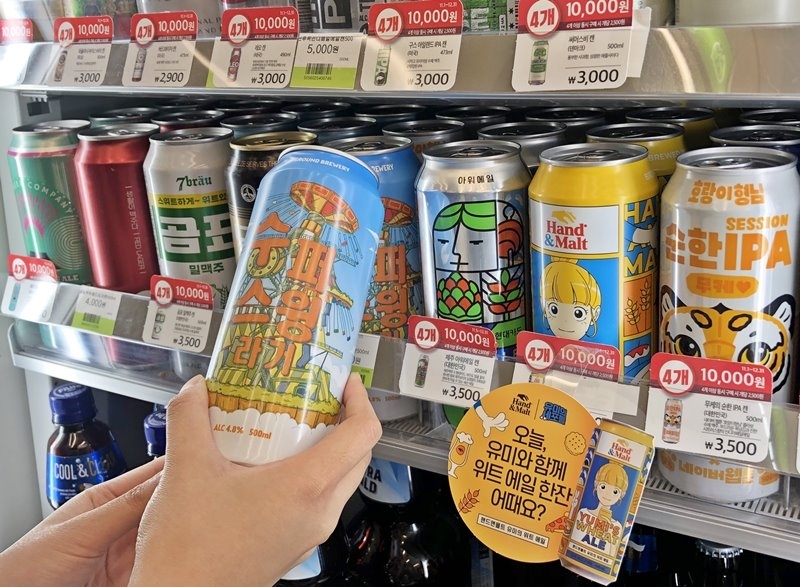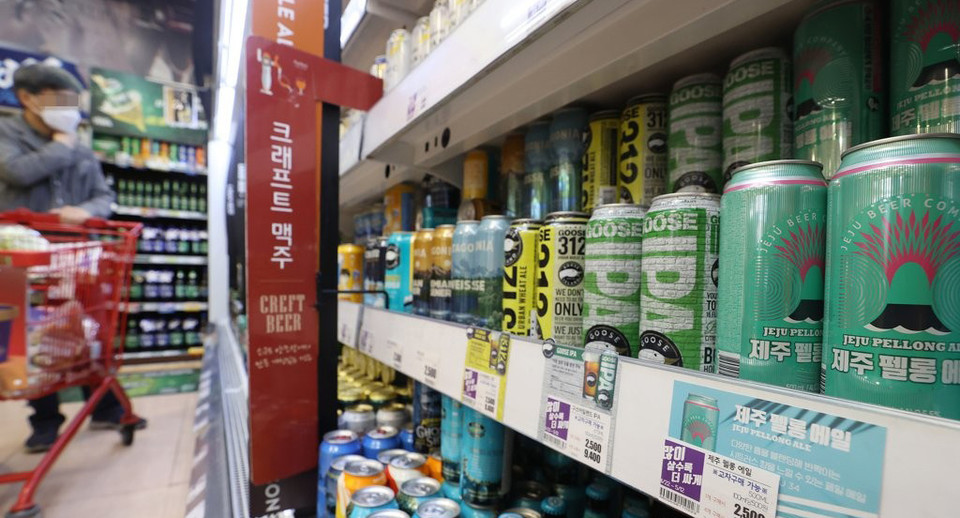South Korea’s growing craft beer boom
Once dominated by mass-produced best-sellers, beer industry is shifting towards more independent, smaller breweries
By Yim Hyun-suPublished : June 27, 2021 - 15:09

Craft beers are enjoying a surge in popularity as more beer drinkers in South Korea seek to broaden their choices, bucking the years-long trend of sticking to major mass-produced beers which have dominated the country.
According to data from convenience store chain CU, sales of craft beer are growing exponentially, up nearly 500 percent in 2020 compared to the previous year.
The upward trend appears to be continuing this year as sales have risen by 239.2 percent as of June 21, compared to the same time last year. In 2019, the company saw a 220.4 percent jump in craft beer sales while overall alcohol sales increased by only 12.3 percent in 2019 and 17.8 percent in 2020 on a year-on-year basis.
The jump in sales was buoyed by Gompyo Beer made by South Korean premium beer manufacturer 7Brau in collaboration with Daehan Flour, which lent its bear mascot to give the product a retro touch. It became an instant hit after its release last May, becoming the best-selling beer at the convenience store chain in April, leaving behind best-sellers such as Cass and Terra.
“The beer industry is rapidly changing, especially since last year’s change in the liquor tax law, going from value-based to volume-based, giving price competitiveness to craft beer manufacturers,” said Hwang Ji-hye, the CEO of online beer platform and marketing company BePlat.
“And then there is the coronavirus pandemic, which drove people away from dining out and prompting people to buy beer at convenience stores instead.”
When craft beers became part of the “four cans for 10,000 won ($8.87)” deal following the new liquor tax law, it led to an exponential growth in sales, Hwang explained.
The local craft beer market grew to 118 billion won last year, nearly twice as big as it was in 2018, according to an estimate from the Korea Craft Brewers Association.
The association has said that the market is set to grow to 370 billion won by 2023.
“South Korean consumers were once satisfied with Cass and Hite. But more imported beers have hit the market since 2010 and more people travel abroad now. And their taste in beer has become more sophisticated,” Hwang said.
According to data from convenience store chain CU, sales of craft beer are growing exponentially, up nearly 500 percent in 2020 compared to the previous year.
The upward trend appears to be continuing this year as sales have risen by 239.2 percent as of June 21, compared to the same time last year. In 2019, the company saw a 220.4 percent jump in craft beer sales while overall alcohol sales increased by only 12.3 percent in 2019 and 17.8 percent in 2020 on a year-on-year basis.
The jump in sales was buoyed by Gompyo Beer made by South Korean premium beer manufacturer 7Brau in collaboration with Daehan Flour, which lent its bear mascot to give the product a retro touch. It became an instant hit after its release last May, becoming the best-selling beer at the convenience store chain in April, leaving behind best-sellers such as Cass and Terra.
“The beer industry is rapidly changing, especially since last year’s change in the liquor tax law, going from value-based to volume-based, giving price competitiveness to craft beer manufacturers,” said Hwang Ji-hye, the CEO of online beer platform and marketing company BePlat.
“And then there is the coronavirus pandemic, which drove people away from dining out and prompting people to buy beer at convenience stores instead.”
When craft beers became part of the “four cans for 10,000 won ($8.87)” deal following the new liquor tax law, it led to an exponential growth in sales, Hwang explained.
The local craft beer market grew to 118 billion won last year, nearly twice as big as it was in 2018, according to an estimate from the Korea Craft Brewers Association.
The association has said that the market is set to grow to 370 billion won by 2023.
“South Korean consumers were once satisfied with Cass and Hite. But more imported beers have hit the market since 2010 and more people travel abroad now. And their taste in beer has become more sophisticated,” Hwang said.

Jeju Beer Company -- a beer manufacture behind Jeju Wit Ale and Jeju Pellong Ale -- which accounts for around 28 percent of the country’s craft beer market, has also enjoyed growing popularity in recent years.
Its sales have gone from 2.2 billion won in 2017 to 15.1 billion won in 2019 before nearly doubling to 33.5 billion won in 2020.
Based on the southern resort island of Jeju, the brewery has embraced the popular holiday destination as its identity, producing merchandise and snacks, as well as offering tours at its brewery.
Last year, it also became the first local craft brewer to go public on Kosdaq -- South Korea’s tech-heavy bourse.
Having expanded its production facility during the first half of this year, the company said issues such as a supply shortage will be tackled.
“We plan to focus on expanding supply and sales channels to make Jeju Beer more accessible,” said CEO Moon Hyuk-kee in a recent statement
“We will also continue to conduct research and develop new products in an effort to lead ‘the third wave’ in South Korea’s beer industry, allowing consumers to enjoy a diverse beer culture.”
With both Gompyo Beer and Jeju Wit Ale leading the charge, Lotte Chilsung Beverage has emerged as a beneficiary of the craft beer boom.
The drink manufacturer produces its own beer, including Kloud. But it is also the original equipment manufacturer for two of the most popular craft beers in the country.
Against this backdrop, the company is expected to see its revenue and operating profit rise by 8.2 percent and 66 percent during the second quarter of this year, with its beer plant operating rate improving from 20 percent last year to 40 percent, Shim Eun-joo, a researcher at Hana Financial Investment, said in a report.
Its sales have gone from 2.2 billion won in 2017 to 15.1 billion won in 2019 before nearly doubling to 33.5 billion won in 2020.
Based on the southern resort island of Jeju, the brewery has embraced the popular holiday destination as its identity, producing merchandise and snacks, as well as offering tours at its brewery.
Last year, it also became the first local craft brewer to go public on Kosdaq -- South Korea’s tech-heavy bourse.
Having expanded its production facility during the first half of this year, the company said issues such as a supply shortage will be tackled.
“We plan to focus on expanding supply and sales channels to make Jeju Beer more accessible,” said CEO Moon Hyuk-kee in a recent statement
“We will also continue to conduct research and develop new products in an effort to lead ‘the third wave’ in South Korea’s beer industry, allowing consumers to enjoy a diverse beer culture.”
With both Gompyo Beer and Jeju Wit Ale leading the charge, Lotte Chilsung Beverage has emerged as a beneficiary of the craft beer boom.
The drink manufacturer produces its own beer, including Kloud. But it is also the original equipment manufacturer for two of the most popular craft beers in the country.
Against this backdrop, the company is expected to see its revenue and operating profit rise by 8.2 percent and 66 percent during the second quarter of this year, with its beer plant operating rate improving from 20 percent last year to 40 percent, Shim Eun-joo, a researcher at Hana Financial Investment, said in a report.








![[Graphic News] More Koreans say they plan long-distance trips this year](http://res.heraldm.com/phpwas/restmb_idxmake.php?idx=644&simg=/content/image/2024/04/17/20240417050828_0.gif&u=)
![[KH Explains] Hyundai's full hybrid edge to pay off amid slow transition to pure EVs](http://res.heraldm.com/phpwas/restmb_idxmake.php?idx=644&simg=/content/image/2024/04/18/20240418050645_0.jpg&u=20240419100350)





![[From the Scene] Monks, Buddhists hail return of remains of Buddhas](http://res.heraldm.com/phpwas/restmb_idxmake.php?idx=652&simg=/content/image/2024/04/19/20240419050617_0.jpg&u=20240419175937)

![[KH Explains] Hyundai's full hybrid edge to pay off amid slow transition to pure EVs](http://res.heraldm.com/phpwas/restmb_idxmake.php?idx=652&simg=/content/image/2024/04/18/20240418050645_0.jpg&u=20240419100350)

![[Today’s K-pop] Illit drops debut single remix](http://res.heraldm.com/phpwas/restmb_idxmake.php?idx=642&simg=/content/image/2024/04/19/20240419050612_0.jpg&u=)